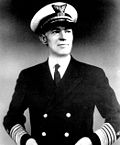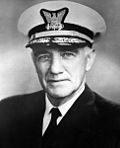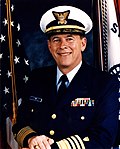| # | Name | Photo | Date of rank [1] | Position [3] | Yrs [2] | Commission [4] | YC [5] | Notes [6] |
|---|
| 1 | waesche Russell R. Waesche |  | 1945-04-044 Apr 1945 | | 1 | 1906 (USRCSSI) [7] | 39 | (1886–1946) |
| 2 | farley Joseph F. Farley |  | 1946-01-011 Jan 1946 | | 4 | 1912 (USRCSSI) [7] | 34 | (1889–1974) |
| 3 | richmond Alfred C. Richmond |  | 1960-06-011 Jun 1960 | | 2 | 1924 (USCGA) | 36 | (1902–1984) Served as Commandant of the U.S. Coast Guard from 1954 to 1960 in the rank of vice admiral. |
| 4 | roland Edwin J. Roland |  | 1962-06-011 Jun 1962 | | 4 | 1929 (USCGA) | 33 | (1905–1985) |
| 5 | smith Willard J. Smith |  | 1966-06-011 Jun 1966 | | 4 | 1933 (USCGA) | 33 | (1910–2000) Superintendent, U.S. Coast Guard Academy, 1962–1965; U.S. Assistant Secretary of Transportation for Safety and Consumer Affairs, 1970–1971. |
| 6 | bender Chester R. Bender |  | 1970-06-011 Jun 1970 | | 4 | 1936 (USCGA) | 34 | (1914–1996) Superintendent, U.S. Coast Guard Academy, 1965–1967. |
| 7 | siler Owen W. Siler |  | 1974-06-011 Jun 1974 | | 4 | 1943 (USCGA) | 31 | (1922–2007) |
| 8 | hayes John B. Hayes |  | 1978-06-011 Jun 1978 | | 4 | 1946 (USCGA) | 32 | (1924–2001) |
| 9 | gracey James S. Gracey |  | 1982-05-2828 May 1982 | | 4 | 1949 (USCGA) | 33 | (1927–2020) |
| 10 | yost Paul A. Yost Jr. |  | 1986-05-3030 May 1986 | | 4 | 1951 (USCGA) | 35 | (1929–2022) |
| 11 | kime J. William Kime |  | 1990-05-3131 May 1990 | | 4 | 1957 (USCGA) | 33 | (1934–2006) |
| 12 | kramek Robert E. Kramek |  | 1994-06-011 Jun 1994 | | 4 | 1961 (USCGA) | 33 | (1939–2016) |
| 13 | loy James M. Loy |  | 1998-05-00May 1998 | | 4 | 1964 (USCGA) | 34 | (1942– ) Administrator, Transportation Security Administration, 2002–2003; U.S. Deputy Secretary of Homeland Security, 2003–2005. |
| 14 | collins Thomas H. Collins |  | 2002-05-3030 May 2002 | | 4 | 1968 (USCGA) | 34 | (1946– ) |
| 15 | allen Thad W. Allen |  | 2006-05-2525 May 2006 | | 4 | 1971 (USCGA) | 35 | (1949– ) Remained on active duty for 36 days after stepping down as commandant while serving as National Incident Commander, Deepwater Horizon oil spill. |
| 16 | papp Robert J. Papp |  | 2010-05-2525 May 2010 | | 4 | 1975 (USCGA) | 35 | (1953– ) U.S. Special Representative for the Arctic, 2014–2017. |
| 17 | zunkunft Paul F. Zukunft |  | 2014-05-3030 May 2014 | | 4 | 1977 (USCGA) | 37 | (1955– ) |
| 18 | michel Charles D. Michel |  | 2016-05-2424 May 2016 | | 2 | 1985 (USCGA) | 31 | (1963– ) Served as Vice Commandant of the U.S. Coast Guard from 2015 to 2016 in the rank of vice admiral. First career judge advocate officer to achieve four-star rank in any service. |
| 19 | ray Charles W. Ray |  | 2018-05-2424 May 2018 | | 3 | 1981 (USCGA) | 37 | (1959– ) |
| 20 | schultz Karl L. Schultz |  | 2018-06-011 Jun 2018 | | 4 | 1983 (USCGA) | 35 | (1961– ) |
| 21 | fagan Linda L. Fagan |  | 2021-06-1818 Jun 2021 | | 4 | 1985 (USCGA) | 36 | (1963– ) Relieved, 2025. First woman to achieve the rank of admiral in the Coast Guard; first woman to lead an armed service. |
| 22 | poulin Steven D. Poulin |  | 2022-05-3131 May 2022 | | 2 | 1984 (USCGA) | 38 | (1962– ) |
| 23 | lunday Kevin E. Lunday |  | 2024-06-1313 Jun 2024 | | 1 | 1987 (USCGA) | 37 | (1965– ) |
|



























